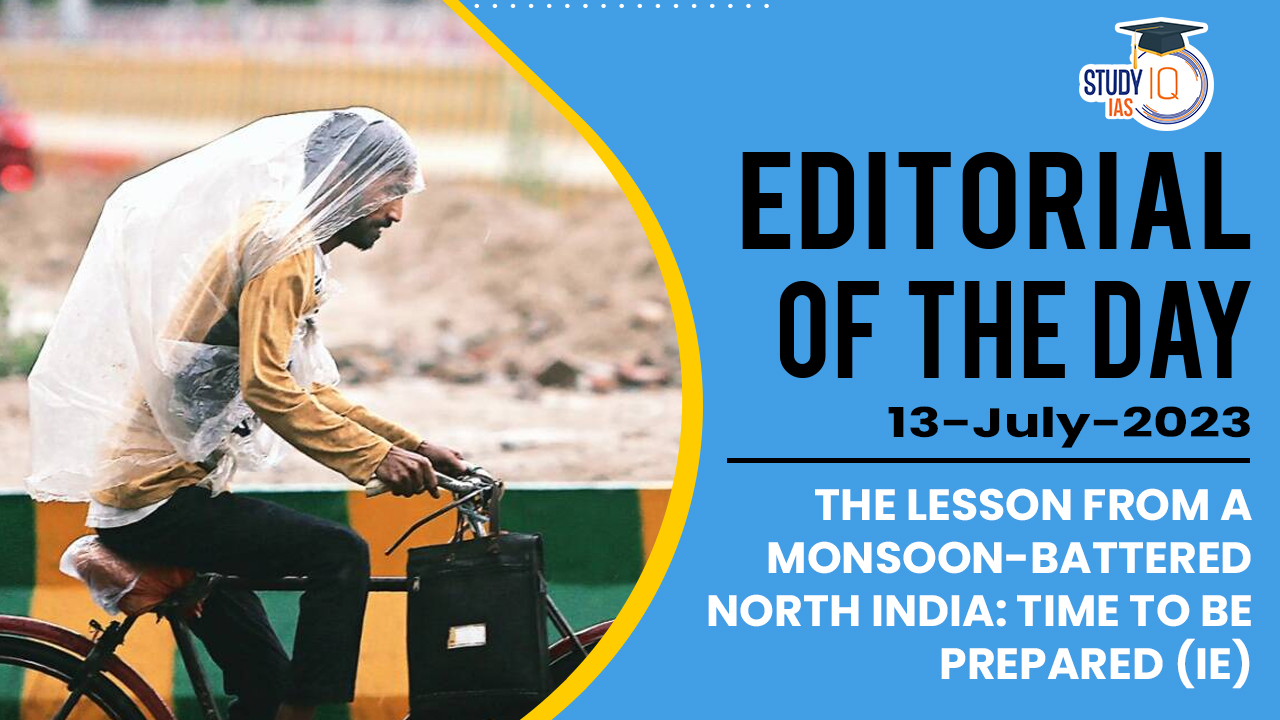Context: The article is discussing the recent heavy rains and flash floods that occurred in parts of North India, particularly in Himachal Pradesh, Haryana, Punjab, and other affected areas. These heavy rains resulted in devastating consequences such as flooded homes, damaged roads and bridges, disrupted communication networks, and isolated communities. The article highlights the destructive impact of the floods, including the loss of lives, and mentions that landslides also occurred as a result of the heavy rainfall. It further suggests that such extreme weather events may become more frequent in the future, emphasizing the need for proactive measures to address and mitigate their impact.
Decoding the Editorial
The article discusses the heavy rains that India has been witnessing that triggered flash floods and left a trail of destruction.
Factors that triggered Heavy Rain in the Region:
There are three main factors that can trigger heavy rains in the region, including the Himalayas.
- Active Monsoon:
- The first factor is an active monsoon, characterised by strong winds in the lower layers of the atmosphere.
- These winds bring moisture into the region from either the Bay of Bengal or the Arabian Sea.
- Large-Scale Atmospheric Forcing:
- The second factor is a large-scale atmospheric forcing, specifically in the form of outflows in the upper layers of the atmosphere.
- These outflows move eastward through mid-latitude troughs, which can direct the flow of moisture towards the Himalayas.
- Orographic Uplift and Steep Terrain:
- The third factor involves deep convection triggered by orographic uplift, combined with the steep terrain of the Himalayas.
- When air encounters the elevated terrain of the Himalayas, it is forced to rise, leading to the formation of clouds and precipitation.
- Thus, the recent heavy rainfall and floods experienced last weekend in North India were a result of favourable synoptic conditions that included an active monsoon with strong moist easterly winds entering the region, an eastward moving mid-latitude trough in the upper layers of the atmosphere, and moisture intrusion from the North Arabian Sea.
- Similar synoptic conditions were responsible for previous flood events, such as the floods in Uttarakhand in 2013 and the floods in Pakistan in 2010.
The article goes on to discuss the characteristics of monsoon rainfall in the region and highlights the recent increasing trend in extreme rainfall events.
Characteristics of Monsoon Rainfall:
- The monsoon rainfall in this region does not occur evenly throughout the monsoon season.
- Instead, all the seasonal rainfall, which ranges from about 80-100 cm, falls within a relatively short duration of 130-150 hours.
- Half of the seasonal rainfall, around 40-50 cm, occurs in only 30-40 hours.
- The other half of the season experiences lighter and moderate rainfall.
- This pattern suggests that periods of heavy rain contribute significantly to the overall seasonal total. During heavy rainfall events, a significant amount of rainwater drains away as runoff, especially when the soil is already wet.
Increasing Trend in Extreme Rainfall:
- Recent studies indicate an increasing trend in extreme rainfall events, particularly in central India.
- The number of extreme rainfall events, defined as rainfall exceeding 15 cm in 24 hours, has tripled in the region.
- Additionally, the duration of rainstorms over central India has also tripled.
- The observations further reveal that during the monsoon, the total number of rainy days and rainy hours decreases, implying that when it does rain, it tends to rain heavily.
Himalayan Region and Extreme Rainfall:
- The Himalayan region, with its complex topography and varied weather patterns, is prone to extreme rainfall events.
- Studies indicate that 65% of areas in the region have shown a positive trend in the frequency of daily rainfall extremes.
-
- For instance, the 2013 floods in Uttarakhand highlighted the region as one where deep, intense convective clouds are likely to form. Instances of such deep convection have increased over time.
Climate Change and Factors Contributing to Extreme Rainfall:
- Climate change is considered one of the main factors contributing to the increase in extreme monsoon rainfall.
- Warmer temperatures lead to increased evaporation, resulting in more moisture in the atmosphere.
- This additional moisture, combined with weather systems and the unique geography of the region, leads to heavy rainfall events.
- Changes in land use and land cover are also believed to contribute to the increase in extreme monsoon rainfall, particularly in terms of intensity.
Arctic Melting:
- The Arctic is experiencing warming and the melting of sea ice due to human influence.
- There is growing evidence of the impact of Arctic warming on the monsoon climate through mid-latitude circulation.
- Specifically, the frequency of blocking highs and deep mid-latitude troughs, similar to the synoptic conditions observed recently, is likely to increase as a result of Arctic warming.
Future Projections:
- The IPCC’s scenarios for climate change indicate that these increasing trends in extreme rainfall will continue.
- Multi-day flood events are projected to increase at a faster rate compared to single-day events, potentially leading to severe consequences.
Mitigation Strategies:
To mitigate floods and address the increasing threat of extreme precipitation, there is a need for a multi-pronged approach that includes both proactive and reactive strategies.
- Robust early warning system: Implementing a reliable early warning system that utilises meteorological observations, including a Doppler weather radar and high-resolution numerical weather prediction models. Advanced techniques like artificial intelligence and machine learning can be employed to interpret the radar data and model forecasts.
- Continuous monitoring and advanced flood warning system: Continuously monitoring rainfall patterns, river levels, and implementing an advanced flood warning system to provide timely alerts and information.
- Flood risk maps: Developing flood risk maps that consider factors such as topography, historical flood data, and hydrological modelling to assess vulnerability, identify high-risk zones, and guide targeted actions.
- Climate-resilient infrastructure: Improving and maintaining climate-resilient infrastructure, such as drainage systems and channels, to prevent waterlogging and efficiently manage excess rainfall.
- Land use planning and zoning regulations: Proper implementation of land use planning and zoning regulations, designating areas prone to flash floods as non-residential or restricted areas to minimise human exposure to flood risks.
- Protection and restoration of natural ecosystems: Promoting the protection and restoration of natural ecosystems, such as forests and wetlands, as they act as natural buffers, absorbing rainfall and reducing runoff.
- Awareness campaigns: Conducting awareness campaigns to educate and influence people to take appropriate actions during floods, including evacuation procedures, first aid provision, and obtaining information from reliable sources.
By recognizing the increasing threat of extreme precipitation and implementing this multi-pronged approach, India can enhance its resilience to extreme weather events, including floods, and mitigate their impacts.


 Personality Rights in India: Expanding P...
Personality Rights in India: Expanding P...
 Judicial Recognition of Child Traffickin...
Judicial Recognition of Child Traffickin...
 Misrepresentation and Fraud in Digital T...
Misrepresentation and Fraud in Digital T...

























